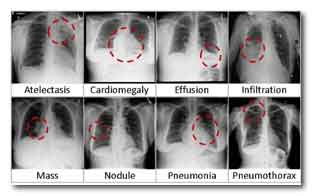|
The U.S. NIH Clinical Center recently released to
the scientific community over 100,000 anonymized
chest x-ray images and their corresponding data,
from more than 30,000 patients, including many with
advanced lung disease.

IMAGE:
Eight common thoracic diseases observed in chest
X-rays that validate a challenging task of
fully-automated diagnosis.
The release will allow researchers across the
country and around the world to freely access the
datasets and increase their ability to teach
computers how to detect and diagnose disease.
Ultimately, this artificial intelligence mechanism
can lead to clinicians making better diagnostic
decisions for patients.
Patients at the NIH Clinical Center, the nationís
largest hospital devoted entirely to clinical
research, are partners in research and voluntarily
enroll to participate in clinical trials.
With patient privacy being paramount, the dataset
was rigorously screened to remove all personally
identifiable information before release.
Reading and diagnosing chest x-ray images may be a
relatively simple task for radiologists but, in
fact, it is a complex reasoning problem which often
requires careful observation and knowledge of
anatomical principles, physiology and pathology.
Such factors increase the difficulty of developing a
consistent and automated technique for reading chest
X-ray images while simultaneously considering all
common thoracic diseases.
By using this free dataset, the hope is that
academic and research institutions across the
country will be able to teach a computer to read and
process extremely large amounts of scans, to confirm
the results radiologists have found and potentially
identify other findings that may have been
overlooked.
In addition, this advanced computer technology may
also be able to help identify slow changes occurring
over the course of multiple chest x-rays that might
otherwise be overlooked, to benefit patients in
developing countries that do not have access to
radiologists to read their chest x-rays, and to
create a virtual radiology resident that can later
be taught to read more complex images like CT and
MRI in the future.
With an ongoing commitment to data sharing, the NIH
research hospital anticipates adding a large dataset
of CT scans to be made available as well in the
coming months.
For more information
Wang X, Peng Y, Lu L, Lu Z, Bagheri M, Summers RM.
ChestX-ray8: Hospital-scale Chest X-ray Database and
Benchmarks on Weakly-Supervised Classification and
Localization of Common Thorax Diseases. IEEE CVPR
2017,
Link...
NIH Clinical Center
Link...
U.S. National Institutes of Health (NIH)
Link...
MDN |